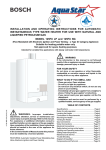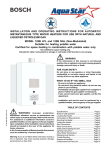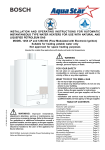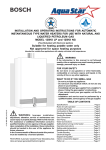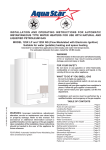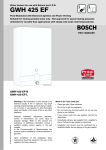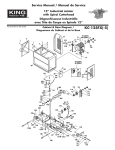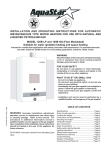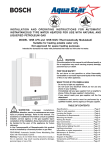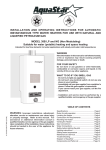Download AquaStar 125FX LP Operating instructions
Transcript
INSTALLATION AND OPERATING INSTRUCTIONS FOR AUTOMATIC INSTANTANEOUS TYPE WATER HEATER FOR USE WITH NATURAL AND LIQUEFIED PETROLEUM GAS MODEL 125FX LP and 125FX NG (Flow Modulated with Electronic Ignition and Power Venting a Type III Category Appliance) Suitable for heating potable water only Not approved for space heating purposes Intended for variable flow applications with steady cold water inlet temperatures. For preheated domestic hot water, install the 125 BS model. For recirculating applications, install the 125 BL model. WARNING If the information in this manual is not followed exactly. A fire or explosion may result causing property damage, personal injury or death. FOR YOUR SAFETY Do not store or use gasoline or other flammable, combustible or corrosive vapors and liquids in the vicinity of this or any other appliance. WHAT TO DO IF YOU SMELL GAS - Close gas valve. Open windows. - Do not try to light any appliance. - Do not touch any electrical switch; do not use any phone in your building. - Immediately call your gas supplier from a neighbors phone. Follow the gas suppliers instructions. - If you cannot reach your gas supplier, call the fire department. - Installation and service must be performed by a qualified installer, service agency or the gas supplier. 6 720 606 455 (01.05) JS TABLE OF CONTENTS WARNING : Improper installation, adjustment, alteration, service or maintenance can cause injury or property damage. Refer to this manual. For assistance or additional information consult a qualified installer, service agency or the gas supplier. Upon completion of the installation, these instructions should be handed to the user of the appliance for future reference. FEATURING: Automatic Variable Power Modulating Gas Valve, Electronic Ignition and Power Venting Specifications .................................................... Page 2 Rules for safe operation .................................... Page 4 Locating the Heater ............................................ Page 4 Combustion Air Requirements ............................ Page 5 Mounting the Heater ........................................... Page 6 Venting the Heater ............................................. Page 6 Gas Connections ............................................... Page 9 Water Connections .......................................... Page 10 Electrical Connections ...................................... Page 11 Safety before turning on the heater ................... Page 12 Lighting and Operating instructions .................. Page 12 Setting water temperature ................................ Page 12 Maintenance & Service ..................................... Page 13 Trouble Shooting .............................................. Page 14 Diagram of AquaStar ......................................... Page 17 Components and Parts List .............................. Page 18 Principle of Operation: When a hot water faucet is opened, the flow of water through the heater causes the gas valve to open. At the same time a microswitch is activated which sends a spark to the pilot. The flame sensor confirms that the pilot has been lighted and allows the first two burners to ignite. The flame sensor confirms correct activation and all burners ignite. The pilot goes out. The power exhaust system runs as long as the burners are on. The heat exchanger coils absorb the heat generated by the burners and transfer heat to the water. When the hot water faucet is shut off, the gas valve automatically closes and the burners turn off, followed immediately by the exhaust system. Your hot water faucet is an ignition key to turn on the water heater, giving you control over your hot water energy use. Every time you turn off your hot water faucet, the energy consumption for hot water returns to zero. AquaStar 125FX LP and 125FX NG Specifications FEATURES Shipping Weight 50.6 LB - Electronic Pilot Ignition Net Weight 44 LB - On/Off switch to activate system 2.0 GPM at 90° rise - Power Venting with safety shutoff 4.0 GPM at 45° rise - High Quality Materials for Long Working Life. Min. Water Flow 1/2 gal/min - Copper heating coils for endless supply of hot water. 120V/60Hz 1.2 Amps - Burner output proportional to hot water flow demand for maximum energy efficiency. LP GAS Supply Pressure inlet. min. 11 W.C.* max. 14 W.C.* - Safety flame sensor at pilot burner. LP GAS Manifold pressure 9.9 W.C.** - Automatic overheating protection shut-off sensor. Natural Gas Pressure inlet - Stainless steel burners with stabilized blue flame. - Built-in corrosion resistant power venter. - Compact space saver: mounts on a wall with two hooks. AQ125FXNG Gas input AQ125FXLPG max. 130 000 Btu/hr 125 000 Btu/hr min. 28 000 Btu/hr 28 000 Btu/hr Water Connection 1/2 Thread fitting H x W x D 29 3/4 x 18 1/4 x 8 3/4" Vent 4 (Category III Gas Appliance) Gas Connection 1/2 NPT thread Min. Water Pressure 18 Psi Max. Water Pressure 150 Psi min.: 7 W.C.* max.: 14 W.C.* Natural Gas Manifold Pressure 5.38 W.C.** * Inlet gas pressure must not exceed this value ** For purposes of input adjustment - Easily removable one-piece cover. - Easy one person installation. - Adjustable water flow restrictor to ensure that water flow demand will not exceed the heating capacity of the heater. UNPACKING THE AQUASTAR HEATER This heater is packed securely. The box includes two water connection fittings, a control knob, a gas pressure regulator, a pressure relief valve, an incandescent particle tray, two hooks for hanging the heater, this manual, a personal letter, a warranty statement and a warranty registration card. Do not lose this manual as there is a charge for replacement. Please complete and return the enclosed warranty registration card. 2 D084_089 FRONT VIEW SIDE VIEW MINIMUM INSTALLATION CLEARANCES FROM COMBUSTIBLE AND NON COMBUSTIBLE MATERIALS FOR ALCOVE OR CLOSET INSTALLATIONS MODEL 125FX TOP (A) 12" FRONT (B) 4" BACK 0" SIDES 4" FLOOR (C) 12" * FLUE DIAMETER 4" * Some local codes require 18 in garage installations AQUASTAR MODEL 125FX 3 GENERAL RULES TO FOLLOW FOR SAFE OPERATION 1. You should follow these instructions when you install your heater. In the United States: The installation must conform with local codes or, in the absence of local codes, the National Fuel Gas Code ANSI Z223.1/NFPA 54. In Canada: The Installation should conform with CGA B149.(1,2) INSTALLATION CODES and /or local installation codes. 2. Carefully plan where you install the heater. Correct combustion air supply and flue pipe installation are very important. If not installed correctly, fatal accidents can be caused by lack of air, carbon monoxide poisoning or fire. 3. The place where you install the heater must have enough ventilation. The National Fire Codes do not allow gas fired water heater installation in bathrooms, bedrooms or any occupied rooms normally kept closed. See the section below on locating the heater. 4. You must install your heater so that the venting complies with all requirements. Venting must comply with all requirements for Category III gas appliances. See section on Venting the Heater, pages 6 and 7. 5. The appliance must be disconnected from the gas supply piping system during any pressure testing at pressures in excess of 1/2 Psig (3.5 kPa). The appliance must be isolated from the gas supply piping during any pressure testing of the gas supply piping system at test pressures in excess of 1/2 Psig (3.5Kpa). The appliance and its gas connection must be leak tested before placing the appliance in operation. 6. Keep water heater area clear and free from combustibles and flammable liquids. Do not locate the heater over any material that might burn. Do not install heater over carpeting. 7. Correct gas pressure is critical for the optimum operation of this heater (see specifications on page 2 and chart on page 9). Gas piping must be sized to provide the required pressure at the maximum output of the heater. Check with your local gas supplier, and see the section on connecting the gas supply. 8. Should overheating occur or the gas supply fail to shut off, turn off the gas supply at the manual gas shut off valve on the gas line. 9. Do not use this appliance if any part has been under water. Immediately call a qualified service technician to inspect the appliance and to replace any part of the control system and any gas control that has been under water. The heater may still operate even when improperly vented. It will, however, be less efficient and could eventually damage the heater. It could even result in human sickness or death due to oxygen deprivation and carbon monoxide poisoning. Before installing the unit, be certain you have the correct heater for your type of Gas Propane or Natural Gas. Identification labels are found on the shipping box, and on the rating plate which is located on the right side panel of the cover. Also, each burner orifice is stamped with a number (79 for LPG and 120 for Natural Gas). Follow the guidelines below: 1. National building codes require that you do not install this appliance in bathrooms, bedrooms, unvented closet or any occupied rooms normally kept closed. 2. Simultaneous operation of other appliances such as exhaust fans, ventilation systems, clothes dryers, fireplaces or wood stoves could create a vacuum effect in your home which could cause dangerous combustion by-products to spill back into your home rather than venting to the outside through the flue. Confirm that your Aquastar is venting properly when all these other appliances are running. See page 8 to test venting performance. Do not obstruct the flow of combustion air to the appliance. This appliance is power vented and uses room air. Note: Electrical power is required to operate the power exhaust. Proper air supply to the appliance is essential. If installed near a clothes dryer it is very important that the dryer be properly vented. Failure to properly vent a dryer could result in a gradual accumulation of lint on the water heater fin coils and burners, leading to a dangerous condition of vent blockage and poor, unsafe combustion. 3. Your hot water lines should be kept short to save energy. It is always best to have hot water lines insulated. WARNING: DO NOT INSTALL IN AN AREA WHERE IT COULD FREEZE. This heater is neither designed for nor approved for outside installation. Drain the heater entirely if freezing temperatures are anticipated in area where heater is installed by disconnecting both the inlet and outlet elbow connections at the rear of heater. Additionally, remove the drain plug under the water valve. See Fig 0. 10.When installed, the appliance must be electrically grounded in accordance with local codes or, in the absence of local codes, in accordance with the National Electrical Code ANSINFPA 70 and/or the CSA 22.1 Electrical Code. PROPER LOCATION FOR INSTALLING YOUR HEATER Carefully select the location of your new heater. For your safety and for proper heater operation, you must provide an abundant supply of combustion air and a proper venting installation. 4 Fig. 0 - Water heater drain plug WARNING: Flammable materials, gasoline, pressurized containers, or any other items or articles that are potentially fire hazards must NOT be placed on or adjacent to the heater. The appliance area must be kept free of all combustible materials, gasoline and other flammable vapors and liquids. COMBUSTION AIR REQUIREMENTS The AquaStar water heater holds cold water in its copper heat exchanger and brass water valve when not in use. Because of this, any cold air that comes in through the units vent pipe is capable of freezing these components. This Installation Manual specifies the vent length requirements and the amount of combustion air required for this unit. When all requirements are followed, the unit will operate properly and safely. However, there may still be a risk of freezing due to negative draft if all the combustion appliances in the area are not being supplied with a sufficient amount of make-up air. A wood stove or furnace can rob the make-up air in the AquaStars vent pipe, leaving the cold infiltrating air capable of freezing the cold water in the AquaStar heat exchanger. To prevent this the FX Hood vent terminator, which should have been acquired separately with the water heater, needs to be installed on the end of the horizontal vent run (see page 7). The FX Hood is an approved vent terminator for the Aquastar 125FX and has a built in back draft flapper. Observe the following instructions concerning combustion air. Appliances located in unconfined spaces: a) An unconfined space is one whose volume is greater than 50 cubic feet per 1000 Btu per hour of the combined rating of all appliances installed in the space. That would be 6500 cubic feet for the AquaStar 130B alone. b) In unconfined spaces in buildings of conventional frame, masonry, or metal construction, infiltration is normally adequate to provide air for combustion, ventilation, and dilution of flue gasses. Appliances located in confined spaces: The confined space must be provided with two permanent openings, one commencing within 12 inches of the top and one commencing within 12 inches of the bottom of the enclosure. Each opening must have a minimum free area of one square inch per: 1000 Btu/hr if all air is taken from inside the building. 2000 Btu/hr if all air is taken from the outside by horizontal ducts. 4000 Btu/hr if all air is taken from the outside by direct openings or vertical ducts. Or the confined space must be provided with one permanent opening or duct that is within 12 inches of the ceiling of the enclosure. This opening must have a minimum free area of one square inch per: 3000 Btu/hr if all air is taken from the outside by a direct opening or vertical duct. Louvers, grills and screens have a blocking effect. If the effective free area is not known, assume it is 20 % to 25% of the total opening for wood louvers and 60 % to 75% for metal louvers. Refer to the National Fuel Gas Code for complete information. In buildings of tight construction all air should be taken from outside. This product is not approved for manufactured homes (mobile home), recreational vehicles (RV) or boats. Reference ANSI Z21.10.3. This product is neither designed or approved for outside installations. CLEARANCES The Aquastar 125FX is design certified for installation on a combustible wall and for installation in an alcove or closet with the minimum clearances to combustible and non combustible construction listed below A. Top 12 inches (305 mm)* B. Front 4 inches (102 mm) C. Back 0 inches D. Sides 4 inch (102mm) E. Bottom 12 inches (305 mm)* * Some local codes require 18 in garage installations. Clearance from vent pipes is dependent upon the clearance rating of the venting material used. Single wall flue pipe is approved for 3 clearance for this appliance. Note: this clearance can be reduced if combustible material are protected as per table VI of the National Fuel Gas Code. MOUNTING INSTALLATION The Aquastar 125FX is design certified for mounting on a wall. Secure the two L shaped hooks, which are provided with heater, to a wall surface. Place them 13 ¼ apart as shown in Fig 2. Do not install this appliance on a carpeted wall or over floor covering which is combustible, such as carpet. The heater must be mounted on a wall using appropriate anchoring materials. If wall is a stud wall sheathed with plasterboard, it is recommended that support board(s) either 1x4s or 1/ 2" (minimum) plywood first be attached across a pair of studs and then the heater should be attached to the support boards. See Fig 2. In earthquake-prone zones, CEC recommends that installers use a large washer and lag screw through the existing holes used to hang the heater to affix the upper third of the heater to the mounting board. To affix the lower third of the heater, CEC recommends that two new holes be drilled in the heaters frame, each one 16 inches below the top two holes, and that washers and lag screws be used to secure the lower portion of the heater to a spacing board. Expansion and contraction of piping due to changing water temperature in the pipes imparts movement to the heater which, if mounted directly to a brittle, friable board, such as plasterboard, can cause failure of mounting. 5 WALL STUDS 13 ¼ SUPPORT BOARD 1 X 4 SPACE BOARD Fig. 2 - Mounting the Heater The incandescent particle tray (shipped loose in the carton with the water heater) must be attached at the bottom of the water heater front cover at the time of installation. Use the screws provided. See figure 3. SCREWS INCANDESCENT PARTICLE TRAY Fig. 3 - Incandescent Particle Tray Illustration VENTING WARNING: Do not reduce the vent pipe size. This appliance must be vented horizontally to the outside with sealed single wall vent pipe following all local ordinances and specifications for installing a power vented Category III appliance. The vent system must be installed by a qualified installer in accordance with all applicable local gas codes. The venting system must be designed and constructed so as to develop a positive flow adequate to remove flue gases to the outdoors. Minimum vent size diameter must be 4. The appliance must be located as close as practicable to a vent terminal. Maximum vent length is 15 feet (4.6m) with two 90degree elbows. This unit may be directly connected to an approved vent termination with a 90-degree elbow. The vent pipe connections must be secured to each other with a minimum of 4 sheet metal screws per connection, and all seams must be sealed with an approved high temperature silicone sealant and aluminum duct tape. The vent system must be gas tight. See Fig 4 for suggested venting installation diagrams. For best results, the horizontal vent system should be as short and straight as possible. Vent pipe must be single wall galvanized steel or stainless steel vent pipe. The maximum horizontal length of vent pipe is 15 feet. 2 elbows are allowable within this maximum vent length. For each additional elbow deduct 5 feet from maximum vent length. Any vertical portion of the vent pipe that is part of the horizontal vent system must be considered part of the allowable 15 foot maximum. When the horizontal vent run exceeds 5 feet the following criteria must be observed: - Support the vent run at 4-foot intervals with overhead hangers. - Horizontal sections of vent connectors must rise ¼ for every foot of horizontal length. Any vent section greater than 45 degrees from vertical is considered horizontal. Note: Single wall vent pipe cannot be used in any concealed locations and should not be used in any unheated space without an insulated chase. Unsealed 5 B-Vent may be used as a chase for straight lengths (no elbows) of 4 single wall vent pipe. All connections of the 4 single wall vent within the 5 B-Vent must be properly sealed. A 1 clearance is required from the B-Vent pipe to combustibles. CAUTION: Aquastar power vent system must be installed by a qualified agency in accordance with these instructions. If improperly installed a hazardous condition such as an explosion or Carbon Monoxide poisoning could result. Controlled Energy Corporation will not be responsible for improperly installed appliances. Freeze Warning: As mentioned on Page 5, negative air pressure in cold climates will cause a reverse airflow in the vent system that can freeze and damage the Aquastar heat exchanger when not in use. To prevent this the FX Hood vent terminator, which should have been acquired separately with the water heater, needs to be installed on the end of the horizontal vent run (see page 7). The FX Hood is an approved vent terminator for the Aquastar 125FX and has a built in back draft flapper. Plan the vent system so that code and manufacturers clearances are maintained. The minimum clearance from the top of the heater is 12 inches. Single wall vent pipe requires a 3-inch clearance from combustibles. In all cases, follow local codes: - In Canada, CAN/CGA-B149 Installation Code for detailed requirements. - In USA, ANSI Z223.1 latest edition, National Fuel Gas Code for detailed. Spill Switch Safety: The 125FX is equipped with a Spill Switch; its mounted on the left side of the draft diverter (Flue gas safety device - #9 on page 19). Before leaving the installation site verify proper Spill Switch operation by temporarily blocking termination outlet. The unit will shut down when flue gases are blocked. You must reset the electrical power to the heater after this safety test has been conducted, otherwise the unit will not operate. 6 4 single wall sealed vent pipe Approved Vent Terminal (FX Hood or other approved terminal) The FX Hood is design approved with the Aquastar 125FX and has a built in back draft flapper to prevent negative air from freezing the Aquastar see Fig. 5 for restrictions in location of vent terminal. HORIZONTAL SIDE WALL * Maximum 15 feet, maximum 15 feet with 2 elbows. Deduct 5 feet for each additional elbow. G181_274 Approved Vent Terminal (FX Hood or other approved terminal) The FX Hood is design approved with the Aquastar 125FX and has a built in back draft flapper to prevent negative air from freezing the Aquastar see Fig. 5 for restrictions in location of vent terminal. Fig 4: Some Venting Guide Suggestions An approved side wall vent terminal must be used when the water heater is vented through a side wall. Locate in accordance with ANSI Z223.1 and local applicable codes. See Fig 5 for restrictions in location of vent terminal in relation to opening doors and windows, grade, and forced air inlets. Be certain that snow and ice will not interfere with the vent. 7 The approved vent terminal must be installed so that flue gases will not jeopardize people, overheat combustible structures or enter into buildings, and so that proper clearances are maintained (See Fig 5). a) The vent terminal shall not be less than 7 feet above a public walkway. b) The vent terminal shall terminate at least 3 feet above any (mechanical) air inlet within 10 feet. c) The vent terminal shall not be within a 6-foot radius from a gas meter or regulator. d) The vent terminal shall be a minimum of 6 feet from any combustion air inlet. e) The vent terminal shall terminate from an opening window, at least 4 feet below or 4 feet horizontally from the opening. f) The vent terminal shall terminate from a door, at least 1 foot above and 4 feet horizontally from the door. g) The vent terminal shall not be less than 3 feet from an adjacent building. h) The vent terminal shall not be less than 1 foot above grade. 1 MI N 4 SO FF 1 VENT HOOD MUST BE MOUNTED ONE FOOT MINIMUM ABOVE DOORS AND WINDOWS IT VENT HOOD 4 MI MI MI N VENT HOOD MUST BE MOUNTED FOUR FEET AWAY FROM DOORS AND WINDOWS N 4 MI N VENT HOOD MUST BE MOUNTED FOUR FEET MINIMUM BELOW WINDOWS 7 M PU INIM BL IC UM A WA BO LK VE WA Y N N 4 D CE OR 10 F Y N AN THI VE W I O T AB NLE 3 I AIR T E OO AD E F E GR N O OV AB Fig 5: Side wall exit locations for mechanical draft vent terminals 8 MI GAS PIPING, CONNECTIONS and Gas Regulator Before connecting the gas supply, check the rating plate on the right side of the front cover to be sure that the heater is rated for the same gas to which it will be connected. In the United States: The installation must conform with local codes or, in the absence of local codes, the National Fuel Gas Code ANSI Z223.1/NFPA 54. In Canada: The Installation should conform with CGA B149 INSTALLATION CODES and /or local installation codes. GAS LINE SIZING FOR NATURAL GAS Follow boxed numbers for piping just one Aquastar 125FX (example: 3/4 B.I. Natural Gas pipe for 30 ft. will handle 152,000 btus). For multiple appliances combine the total btu input load and then refer to applicable chart below. Maximum Capacity of pipe in Cubic Feet of Gas per Hour for Gas Pressure of 0.5 Psig or less and a Pressure drop of 0.3 in Water Column. (Based on a 0.60 Specific Gravity Gas) Btu numbers given in thousands. Nominal Iron Length of Black Iron Pipe, Feet Pipe Internal Size, Diameter inches inches 10 20 30 40 50 60 70 80 90 100 125 150 175 200 1/4 0.364 32 22 18 15 14 12 11 11 10 9 8 8 7 6 3/8 0.493 72 49 40 34 30 27 25 23 22 21 18 17 15 14 1/2 0.622 132 92 73 63 56 50 46 43 40 38 34 31 28 26 3/4 0.824 278 190 152 130 115 105 96 90 84 79 72 64 59 55 1 1.049 520 350 285 245 215 195 180 170 160 150 130 120 110 100 1 1/4 1.380 1050 730 590 500 440 400 370 350 320 305 275 250 225 210 1 1/2 1.610 1600 1100 890 760 670 610 560 530 490 460 410 380 350 320 2 2.067 3050 2100 1650 1450 1270 1150 1050 990 930 870 780 710 650 610 2 1/2 2.469 4800 3300 2700 2300 2000 1850 1700 1600 1500 1400 1250 1130 1050 980 3 3.068 8500 5900 4700 4100 3600 3250 3000 2800 2600 2500 2200 2000 1850 1700 4 4.026 17,500 12,000 9,700 8,300 7,400 6,80 6,200 5,800 5,400 5,100 4,500 4,100 3,800 3500 FOR LP GAS Maximum Capacity of Pipe in Thousands of BTU per Hour of Undiluted Petroleum Gases (at 11 inches Water Column Inlet Pressure) (Based on a Pressure Drop of 0.5 Inch Water Column). Maximum Capacity of Semi-Rigid Tubing in Thousands of BTU per Hour of Undiluted Liquified Petroleum Gases (at 11 inches Water Column Inlet Pressure) (Based on a Pressure Drop of 0.5 Inch Water Column) Nominal Black Iron Pipe Iron Pipe Length of Pipe, Feet Size, 10 60 70 80 90 100 125 150 1/2 275 189 152 129 114 103 96 89 83 78 69 63 132 Inches 20 30 40 50 3/4 567 693 315 267 237 217 196 185 173 162 146 1 107 732 590 504 448 409 378 346 322 307 275 252 1 1/4 220 149 121 103 913 834 771 724 677 630 567 511 1 1/2 330 229 185 155 141 127 118 108 102 976 866 787 2 622 433 346 299 264 239 220 204 192 1811 1606 1496 Copper Length of Tubing, Feet Outside Diameter, Inch 10 20 30 40 50 60 70 80 90 100 3/8 39 26 21 19 _ _ _ _ _ _ 1/2 92 62 50 41 37 35 31 29 27 26 5/8 199 131 107 90 79 72 67 62 59 55 3/4 329 216 181 145 131 121 112 104 95 90 7/8 501 346 277 233 198 187 164 155 146 138 * Source National Fuel Gas Code NFPA 54, ANSI Z223.1 - No Additional Allowance is necessary for an ordinary number of fittings 9 It is strongly recommended that the natural gas pipe line be 3/4" for the entire distance. If the maximum length is above 40 feet, use 1" line. Flexible tubing is NOT recommended, but if it is to be used, oversize it. With LP gas installation, the recommended sizes are 5/8" up to a maximum of 20 feet distance, 3/4" up to 50 ft distance and 7/8" up to 100 feet. National Fuel Gas Code requires that a sediment trap (drip leg) be installed on gas appliances. The drip leg must be accessible and not subject to freezing conditions. Install in accordance with the recommendations of the gas supplier. NOTE: The AquaStar 125FX is supplied with a gas pressure regulator that must be installed on the heater before attaching the gas supply line. See figure 6. Failure to install the gas regulator as shown in figure 6 will be a violation of CSA certification of the unit. The regulator supplied with the heater is preset for the gas shown on the rating plate to the correct pressure. It is an appliance level regulator designed for (low inlet) pressure (less than 1/2 Psig or 15 W.C.) DO NOT connect to an unregulated or high pressure propane line or to a high pressure commercial natural gas line. GAS INLET PIPE PRESSURE TAP PLASTIC CAP APPLIANCE PRESSURE REGULATOR (with directional arrow on reverse side pointing upward) Fig. 6 - Appliance pressure regulator (with directional arrow on reverse side pointing up) The pressure regulator provided with the heater is adjusted to deliver the proper gas pressure (as indicated on the rating plate and in the manual for altitude up to 2000 feet (660 meters) above sea level. On appliances being installed above 2000 ft (660 meters) elevation, the inlet gas pressure should be set at installation to the value shown below. NOTE: The gas pressures specified below refer to pressures taken at the test pressure nipple on the gas inlet pipe just above the regulator (See Fig 6). These readings should be taken while the heater is operating at full input i.e. maximum water flow with the temperature dial selector turned all the way clockwise. WARNING: The heater must be disconnected from the gas supply piping system during any pressure testing of that system at test pressures in excess of .5 psig. The water heater must be isolated from the gas supply piping system by closing the manual shutoff valve during any pressure testing of the gas supply piping system at test pressures equal to or greater than .5 psig. The water heater, including the pressure regulator provided with it, must not be operated at gas supply pressures in excess of .5 psig. If overpressure has occurred, such as through improper testing of the gas lines or malfunction of the supply system, the gas valve and regulator must be checked for safe operation. When your connections are made, check for gas leaks at all joints (not just the ones you made). Apply some soapy water to all gas fittings and gas valve. Soap bubbles are a sign of a leak. NOTE: Do not apply soap solution to pilot filter screen or pilot orifice area. If you have a leak, shut off the gas. After verifying that required gaskets are in place, tighten appropriate fittings to stop leak. Turn the gas on and check again with a soapy solution. Never test for gas leaks using a match or flame. WATER CONNECTIONS When facing the heater, the cold water inlet is on your right and the hot water outlet is on your left. Although water piping throughout your structure may be other than copper, CEC recommends that copper piping be used for at least three feet before and after the heater (follow local codes if more stringent). Keep water inlet pipe to no less than 1/2 inch diameter to allow the full flow capacity. Remember that water pressure must be sufficient to activate the heater when drawing hot water from the top floor. If the hot and cold connections to the heater are reversed, the heater will not function. The AquaStar 125FX is provided with two S-bend water connection adapters that must be connected to the inlet and outlet fittings of the water valve as shown in Figs 7 and 8. Galvanized or brass 90 degree elbows work best when connected to the S fittings. These fittings seal to the water valve by means of a union connection with a washer type gasket at the joint. No pipe dope or thread tape is to be used at these joints. The Pressure Relief Valve (PRV) should only be fitted to the hot water line. Be certain there are no loose particles or dirt in the piping. Blow out or flush the lines before connecting to the AquaStar. Full port ball valves should be installed on both the cold water feed line and the hot water outlet line to facilitate servicing the heater. For installation on a private well system, be sure that the minimum water pressure is set between 30 and 50 psi. MAXIMUM INLET PRESSURE SETTINGS Altitude 0’ - 2.000 ft 2.000 ft - 4.500 ft Natural Gas inches W.C: 5.38 4.40 Liquid Propane inches W.C: 9.9 7.90 Above 4.500 ft consult your local gas provider. Fig. 7 - Water valve and S bend water connectors - top view 10 - Typical setups are shown below with the pressure relief valve attached. The pressure relief valve is supplied with the heater, and should only be fitted on the hot water outlet as shown. The cold water inlet setup will be identical to diagrams below but without the pressure relief valve. - For ease of installation the piping setup should be prepared as one whole piece with either threaded or sweated connections. The entire assembly will then mount easily against a wall and to the back of the Aquastar. SWEATED ASSEMBLY 1/2 ELBOW S FITTING S FITTING Pressure Relief Valve PIPE PRV TO APPROPRIATE DISCHARGE HWS 1/2 ELBOW PIPE PRV TO APPROPRIATE DISCHARGE The listed pressure relief valve supplied with the heater must be installed at the time of installation. Should a discharge line be added to the PRV no valve is to be placed between the PRV and the heater. No reducing coupling or other restriction may be installed in the discharge line. The discharge line must be installed such that it allows complete drainage of both the PRV and the line. The location of the PRV must be readily accessible for servicing or replacement. and be mounted as close to the water heater as possible. To install the PRV, a suitable fitting connected to an extension on a T fitting can be sweated to the hot water line. See Fig 9. Fig. 8 - Plumbing connections for the Aquastar 125FX CWS THREADED ASSEMBLY Connecting the pressure relief valve (PRV) Fig. 9 - Pressure Relief Valve ELECTRICAL CONNECTIONS WARNING: This heater must be electrically grounded in accordance with the most recent edition of the National Electrical Code, NFPA 70. In Canada, all electrical wiring to the heater should be in accordance with local codes and the Canadian Electrical Code, CSA C22.1 Part 1. Do not rely on the gas or water piping to ground the metal parts of the heater. CAUTION: Label all wires prior to disconnection when servicing controls. Wiring error can cause improper and dangerous operation. Verify proper operation after servicing. The AquaStar 125FX requires an electrical power supply from 120VAC 60Hz circuit and must be properly grounded. - A means for switching off the 120 VAC power supply must be provided. - The heater is wired as shown in the wiring diagram. (Fig 10). E864_020 Fig 10: Wiring Diagram for AQ 125FX 1 2 3 4 5 6 7 8 - microswitch electric control box exhaust fan fuse circuit interrupter electronic control box temperature limiter sensors of exhaust gases 9 - ionization probe (flame sensor) 10 - pilot electrode 11 - pilot electrovalve 12 - gas control valve 13 - burner electrovalve 14 - power cord 11 Open the cold water inlet supply to the heater fully. Open a hot water faucet to permit the water to fill the heater and the piping and to eliminate the air trapped in the system Close the hot water faucet after the water flows freely and all the air has escaped from the system. The water heater is now ready to operate. FOR YOUR SAFETY READ BEFORE OPERATING YOUR HOT WATER HEATER Warning: If you do not follow these instructions exactly, a fire or explosion may result causing property damage, personal injury or loss of life. A. This appliance is equipped with electronic ignition for lighting the pilot and main burners. When turning the heater on, follow these instructions exactly. B. Before operating the unit, set the On/Off switch to the On (I) position. The On/Off switch is located behind the flip-down coverplate on the front panel strip. Smell all around the appliance area for gas. Be sure to smell next to the floor because some gas is heavier than air and will settle on the floor. WHAT TO DO IF YOU SMELL GAS - Do not try to light any appliance. - Do not touch any electric switch; do not use any phone in your building. - Immediately call your gas supplier from a neighbors phone. Follow the gas suppliers instructions. - If you cannot reach your gas supplier, call the fire department. C. Use only your hand to push in the on/off control button. Never use tools. Follow these instructions exactly. If control button is jammed, close the gas supply and call a qualified service technician. Attempted forceful repair may result in a fire or explosion. D. Do not use this appliance if any part has been under water. Immediately call a qualified service technician to inspect the appliance and to replace any part of the control system and any gas control which has been under water. LIGHTING AND OPERATING INSTRUCTIONS 1. STOP! Read the safety information on the front panel of the heater. 2. The gas valve must be turned off by putting the On/Off switch to position O (see fig. 12). Wait five (5) minutes to clear out any gas. If you smell gas, STOP! Follow B in the safety information above. If you dont smell gas, go to next step. 3. This water heater is equipped with a safety pilot burner and an automatic ignition control system. 4. Set the ON/OFF switch (flip down cover plate on front panel strip) marked I/O to the I position. In this position the water heater is ready to use. 5. Verify that the power supply to the appliance is turned on. 12 NOTE: On a first time installation, existence of air in the gas supply line and in the water line may cause some ignition delay. In that case, repeatedly open and close the hot water tap in order to restart the ignition process until all the air has been purged. TO TURN OFF GAS TO APPLIANCE Turn off the manual lever on the gas supply line to the heater and set the ON/OFF switch to the OFF ( 0 ) position, see Fig. 11. To operate the heater, set the ON/OFF switch to position I. The switch is located behind the flip down cover plate on the front panel strip. To shut down the gas to the heater, set the ON/OFF switch to position 0 Temperature Adjustment Knob Decrease temperature and increase flow Increases temperature and decreases flow G661_004 Before operating the heater, make sure that the system is filled with water. 6. Turn the hot water faucet on to the minimum flow required to activate the heater. The automatic ignition system first ignites the safety pilot burner which then ignites the main burner in about 4 seconds. The power exhaust will then activate. 7. The pilot flame will extinguish 10-30 seconds after the burners come on. The burners will remain on until the hot water tap is turned off. G667_091 OPERATING INSTRUCTIONS Fig. 11 - Principles of Operation SETTING THE WATER TEMPERATURE The AquaStar 125FX LP and 125FX NG water heaters have a gas control that modulates burner input in response to flow. Its purpose is to ensure that the hot water temperature will remain steady, although the demand for water flow might vary (down to 1/2 gal/minute). To adjust the temperature on your AquaStar, turn on a hot water faucet to its maximum flow. At the AquaStar, turn the large knob located beneath the main gas controls on the front of the heater all the way to the right (clockwise). See Fig 12. This will produce a temperature rise of approximately 90°F at flow rates between .5 and 2.0 gallons per minute. Given that average incoming water temperatures are 50°F, this heater will produce approximately 140°F water at these flow rates. Turning the dial all the way to the left (counterclockwise) will produce a temperature rise of approximately 45°F for flow rates between 1.0 and 4.0 gallons per minute. This will result in a higher flow rate, but at cooler temperatures. Turning the dial to locations in between will give various temperatures between 140° and 95°F at various flow rates between 2.0 and 4.0 gallons per minute. The position you select on the temperature selector dial will depend on the temperature of the incoming water (50°F is average in the U.S.). In warm weather regions where the incoming cold water is generally warmer, or during the hot weather months in some other areas a midway setting on the temperature selector knob will produce a temperature rise of about 70°F, giving an output of approximately 120°F. At this setting, if it is still necessary, one could mix a small amount of cold water in a shower and have a comfortable shower at about 3 gallons/minute. During the colder months, or in cold climate areas, it might be necessary to set the control all the way clockwise to the right for maximum temperature rise. Never supply the AquaStar 125FX with preheated water, such as in a solar installation: the unit will overheat. It will then shut off on safety when the outlet temperature reaches 185°F. You must purchase a solar model AquaStar125 B LPS or 125 B NGS if you plan to use preheated water with your system. MAINTENANCE AND SERVICE Approximately once a year, the AquaStar should be checked and cleaned. The following operations should be performed by a qualified service person: Vent System: Should be checked annually. Clean and repair as needed. Water Valve: (Part # 8707002459): The water valve on this heater should be serviced periodically, every 3-5 years is recommended. The frequency will depend on the mineral content of the water and conditions of use or whenever signs of corrosion appear at the gas and water valve joint. Pilot Flame: The pilot flame should burn with a clean, sharp, blue flame and should resemble the diagram in Fig. 13. If the flame is soft and yellow, the pilot burner orifice may need to be cleaned or replaced. The pilot flame should be approximately 2 inches long, extending past the flame sensor. If the flame is too small, it will not reach the flame sensor and the burners will not come on. 3mm TEMPERATURE ADJUSTMENT KNOB Fig. 12 - Temperature Adjustment Knob Correct gap between pilot burner tip and electrode tip Piezo Electrode Flame sensor Piezo Electrode Fig. 13 - Characteristic Pilot Flame To clean the pilot burner and/or the pilot orifice: Turn off the gas at the unit (Position O). Remove the cover of the heater. To do so, pull off the temperature knob and unscrew and remove the temperature knob collar. Pull main cover out toward you and lift up and out. The pilot orifices should also be cleaned or replaced. Do not enlarge the orifice (see fig. 14). Do not use any wire or sharp object to clean orifices. Natural gas orifices are large enough that you can usually clean them by blowing through them. LP orifices, on the other hand, are too small to clean and should be replaced. See #3 in Trouble Shooting Section. To access the pilot orifice, remove 2 screws holding pilot assembly in place. Then loosen the compression fitting and lift up pilot burner to expose pilot orifice. 13 3. Water flow is not sufficient to activate heater. Water flow rate at faucet is below minimum flow needed to activate heater. When temperature adjustment knob is turned all the way clockwise, the AquaStar model 125FX requires 1/2 gallon per minute flow to activate the heater. As a reference, this is a flow which would fill a quart jar in 30 seconds. If the temperature adjustment knob is turned fully counterclockwise, a flow rate of 1.1 gallons/minute is required to activate the heater. 4. Bad fuse Check the viability of the fuse (see Fig 10 (#4) for location of fuse). Replace if necessary. PILOT ORIFICE Fig. 14 - Pilot burner with pilot orifice Main Burner Flames: The main burner flames should be blue, with a more intense blue cone in the center core. Yellow flames could be a sign of wrong size gas orifices or dirty burners, or a blockage on the heat exchangers fins. If some burners have yellow flames while others have good flames, it is likely that dust, lint or spider webs have partially clogged the burner venturis. To clean the burners, contact a gas service person. Mineral Scale Build-up: AquaStars, when operated at lower temperature settings, do not accumulate mineral buildup. If however, the heater is used at the higher temperature settings and the water has a high mineral content, periodic descaling may be necessary. The heating coils should be flushed with a descaling solution. Consult your dealer or Controlled Energy for instructions. 5. Water inlet filter is clogged Water flow is restricted, preventing flow needed to activate heater. Clean water inlet filter screen. 6. Cross over in water lines To confirm there is no cross-over in the plumbing, shut off the cold water supply to the AquaStar water heater and open a hot water faucet. There should not be any water flowing at that faucet. Water running is a sign of a plumbing cross-over. Consult your plumber. 7. Microswitch needs to be adjusted or replaced. If you do not hear a click when a tap is opened, the microswitch needs to be adjusted. See Fig. 16 (#1) for location and see Fig. 15 for adjustment. The microswitch may need to be replaced. TROUBLE SHOOTING Problems are stated in upper case, bold face. Most common causes for the problems follow in order of likelihood. The suggested solutions require that the cover be taken off. To do this, pull off the temperature knob and unscrew and remove the temperature knob collar. Pull main cover out toward you and lift up and out. NO SPARK AT THE PILOT 1. On/Off switch is not On (Position I). The On/Off switch is located behind the flipdown cover plate on the front panel strip. See fig. 11. 2. Bad electrical connections. Be certain that all electrical connections are clean, tight, and free of any moisture. 14 Adjusting screw G871_212 Introduction The AquaStar 125FX pilot and burners are ignited by a water flow valve. Numerous water related problems can cause this water valve to malfunction such as: Insufficient water flow volume to activate the burners at its minimum flow requirement; Dirt in the water flow valve causing it to malfunction; Sediment build-up in faucet aerators, or shower heads; Uneven pressures between cold and hot with single lever faucets; Plumbing cross overs. These water flow related problems can cause the heater to deliver less than its full output, or to fail to ignite or to shut down completely. Fig. 15 - microswitch adjustment Pilot does not spark with water flow 1 Close water tap 2 Remove screw cap and unscrew till sparking starts Pilot always sparks without water flow 1 Close water tap 2 Screw in adjusting screw until it stops sparking 3 Screw in turning one and a half turns 3 Continue to screw in turning one and a half turns more 8. Cold incoming water connection made to wrong side of heater Make sure cold water inlet connection is on the right side when you are facing the AquaStar. 9. Water valve parts may be dirty or components damaged First check that venturi is free of dirt particles. Water valve and component parts must be totally free of dirt. Mineral deposits can eventually (3-5 years in hard water areas) corrode the water valve parts to a point where they will need replacing. Any sign of moisture at the bleed hole is a sign that the water valve needs to be replaced immediately. 10. Loose connection at the ECO Ignition sparker will not operate if the electrical circuit is interrupted. Check that the connections to the ECO are secure and tighten if necessary. 11. Reset electrical power to heater If resetting the electrical power corrected the symptom then likely the units Safety Spill switch (Flue gas safety device - #9 on page 19) had tripped from a flue blockage during the previous usage. Inadequate combustion air to the room area can also cause the unit to improperly vent. Improper venting or insufficient combustion air must be corrected. Consult a licensed professional to inspect the installation. SPARKS APPEAR AT PILOT WHEN HOT WATER TAP IS TURNED ON, BUT PILOT AND BURNERS WILL NOT IGNITE 1. Air in the Gas Line Note: Normally this is a problem only at the time of initial installation, after the pipes have been worked on, or after a propane tank has been allowed to empty, or after the heater has been shut down for a long time. Bleed all the air trapped in the gas line by turning the hot water faucet on and off until the air has been cleared from the line. 2. No gas to the AquaStar A. Gas cock on gas line may not be open B. Gas regulator may be shut or damaged. Replace or unjam the regulator. Note: The regulator furnished with the heater is exclusively designed for low gas pressure (less than ½ psig). Excessive pressure will lock it up. Jamming usually happens when using propane gas if the gas pressure between the gas tank and the water heaters gas regulator has not been reduced. See Page 2 for recommended correct gas pressure. To unjam a regulator, consult your gas supplier or call CEC. 3. Pilot orifice clogged or gas valve is dirty Clogging of the pilot burner can be caused by dust in the air or dirt in the gas. The pilot orifice or gas filter may need to be cleaned or replaced. See Fig. 14. 4. Water valve assembly needs to be checked If the pilot orifice is clean, the water valve assembly should be checked. The adjustment screw on the water valve microswitch may not be tight enough (fig. 15). Remove central cap beneath micro-switch assembly, carefully loosen the adjustment screw until the pilot light ignites. At that point retighten the screw one and a half turns. See Fig 15. 5. Pilot electrovalve switch may need to be replaced (See Fig 10). Call CEC. 6. Electronic Control Box may need to be replaced (See Fig 10). Call CEC. PILOT SPARKS CONTINUOUSLY WITH NO WATER RUNNING 1. Microswitch needs adjustment If no water is running, but pilot electrode continuously sparks, the microswitch screw to the water valve needs adjustment. See Figure 15. PILOT LIGHTS BUT BURNERS WILL NOT COME ON 1. Confirm the flame sensor is in its proper position. (see Fig. 13). 2. Sensors for exhaust gases may be loose. The burners will not come on if the powered fan exhaust is not working. Check that the unit is plugged in and that the sensors for the flue gases are secure. 3. Confirm the ECO connections are secure. 4. The Electronic Control Box (Fig 10) may need to be replaced. 5. Burner electrovalve switch may need to be replaced (see Fig. 10). MAIN BURNERS GO OUT DURING HOT WATER USE 1. Deficient exhaustion of flue gases Check that vent is correct and clear of any obstructions, that sensors for flue gases are secure and that electrical connection has been made. If the heater will not come back on, it will be necessary to turn the electrical supply to the heater off and then on again. 2. Flow rate diminished below activation rate Be certain that water flow is not less than required amount to activate heater. 3. Unbalanced pressure in the water lines. The added restriction caused by the Aquastar in the hot water system can result in uneven pressures between the cold and the hot. In such cases when mixing cold water at the tap, the lower hot water pressure may be overpowered by a much higher cold water pressure, which may cause the Aquastar burners to shut down. Make sure faucet aerators or shower heads are free of minerals. Do not add any flow restrictor to the shower head. 4. ECO (overheat sensor) tripped due to overheating Do not feed preheated water to this water heater. 5. Minimum inlet pressure on well pressure tank is inadequate Check the inlet water pressure. On a private well, raise the minimum pressure setting to 30 psi. Confirm that the pressure tank is not water logged. WATER IS TOO HOT 1. Temperature Selection too high Turn the temperature adjustment knob counter-clockwise (to the left) to lower the maximum water temperature. Note: This will increase the activation flow rate. 15 2. Inlet water temperature is too warm or inlet water is preheated Decrease gas pressure. Note: Only the Model 125B S AquaStar should be used if the inlet water is preheated. 3. Inlet filter screen is clogged, restricting flow Remove screen and clean it. WATER IS NOT HOT ENOUGH 1. Temperature selection is set too low. Change the setting. Turn the temperature selector knob clockwise (to the right). Note: this will decrease the activation flow rate. 2. Water flow through the heater is higher than the capacity of the AquaStar to heat it Reduce the flow demand at the faucet. See flow rates at specific temperatures on page 2. 3. Gas pressure is insufficient It is extremely important for a tankless instantaneous water heater to have the right size gas line to obtain the correct gas pressure. See specifications on page 2. Unlike storage tank water heaters, the burners of a tankless water heater must be very powerful to heat water instantaneously since they do this only at the time hot water is actually being used. It is therefore imperative that the gas pressure requirement be met exactly. Insufficient gas pressure will directly affect the water temperature at the time of usage. See page 2 for correct gas pressure settings and see page 9 for proper gas line sizing. 4. Gas supply is insufficient Make sure your main gas line is fully opened. If using LP gas, be sure that the size of the propane tank is adequate to supply the required gas pressure. See gas pipe sizing chart on page 9. 5. Cold water is mixing with the hot water between the AquaStar and the outlet Compare water temperature at outlet of the AquaStar (hold the AquaStars outlet pipe with your hand) and at the tap. If these two are very different, check for mixing valve or plumbing crossover (see NO SPARK AT THE PILOT paragraph 4). Where automatic anti-scald valves are required by code, lower the temperature setting on the AquaStar as much as possible and balance the pressure between cold and hot water after the AquaStar. 6. Parts in water flow valve are corroded so that the gas passage is not fully opening. Contact your service person or Controlled Energy. HOT WATER TEMPERATURE FLUCTUATES 1. Unbalanced pressure in waterlines The added restriction caused by the Aquastar in the hot water system can result in uneven pressures between the cold and the hot. In such cases when mixing cold water at the tap, the lower hot water pressure may be overpowered by a much higher cold water pressure, which may cause the Aquastar burners to shut down. Make sure faucet 16 aerators or shower heads are free of minerals. Do not add any flow restrictor to the shower head. 2. Cold water is mixing with the hot water between the AquaStar and the outlet See #4 under NO SPARK AT THE PILOT. 3. Inlet water pressure is erratic due to inadequate supply water pressure or saturated pressure tank on well system Check the inlet water pressure. On a private well, raise minimum pressure setting to 30 psi. Confirm that the pressure tank is not water logged. 4. Gas pressure is too low See page 2 for correct specifications. EXHAUST FAN DOES NOT OPERATE 1. Check the fuse (see fig 10) 2. Check all electrical connections 3. Check adjustment of fan microswitch FAN CIRCULATES WHEN HOT WATER IS SHUT OFF 1. Check adjustment of fan microswitch Fig. 17 - Diagram of AquaStar 125FX 14 1 3 2 4 5 6 9 13 7 10 8 11 12 1. 2. 3. 4. 5. 6. 7. Heat exchanger Pilot assembly Burner manifold gas pressure test nipple Main gas burner Pilot gas tubing Gas valve Electronic control box 8. 9. 10. 11. 12. 13. 14. Power cord on/off switch Temperature adjustment selector Microswitch Gas inlet gas pressure test nipple Electric box Exhaust Fan 17 Fig. 18 INTERIOR COMPONENTS DIAGRAM AND PARTS LIST 130 18 1 2 3 4 5 6 7 8 9 10 11 12 13 14 15 Front Cover AquaStar Decal Plastic lower snap-on Temperature adjustment knob complete Temperature adjustment knob Exhaust fan assembly Draft diverter Fan protection Flue gas safety device Heat Exchanger Hot water pipe Washer Overheat sensor (ECO) Cold water pipe Main burner assembly 16 17 18 Washer for burner assembly Throttle disc Gas Valve 19 Diaphragm switch 20 21 22 23 24 Main solenoid valve Pilot solenoid valve O-ring Electrode ignition group Pilot burner assembly 25 Injector pilot 26 27 28 29 30 31 32 33 34 35 36 37 38 39 40 41 Pilot gas tube Washer Electronic control box Electric control box On/Off switch Microswitch Water valve Water valve repair kit Slow ignition valve Diaphragm Water inlet filter Selector screw Volumetric water governor Venturi Water connections gasket Water elbow fitting 8 705 421 255 8 701 103 074 8 705 506 451 8 702 000 219 8 702 000 111 8 707 204 023 8 705 505 451 8 701 302 164 8 707 206 185 8 705 406 184 8 700 705 556 8 710 103 045 8 707 206 040 8 700 705 294 8 708 120 298 NG 8 708 120 296 LP 8 710 103 060 8 700 100 189 LP only 8 707 011 811 NG 8 707 011 812 LP 8 708 504 021 NG 8 708 504 049 LP 8 708 501 250 8 708 501 249 8 700 205 120 8 718 107 067 8 708 105 337 NG 8 708 105 491 LP 8 708 200 069 NG 8 708 200 312 LP 8 700 707 349 8 700 103 173 8 707 207 011 8 707 101 021 8 707 200 014 8 707 200 007 8 707 002 534 8 703 406 178 8 708 503 063 8 700 503 053 8 700 507 059 8 708 500 251 8 707 402 015 8 708 205 249 8 710 103 043 8 700 705 472 Fig. 18 - INTERIOR COMPONENTS DIAGRAM AND PARTS LIST 19 Replacement Parts available from North American Distributor CONTROLLED ENERGY CORP. 340 Mad River Park Waitsfield, Vermont 05673 Phone 800-642-3111 Fax (802) 496-6924 www.controlledenergy.com [email protected] VULCANO Termodomésticos S.A. Estrada de Cacia 3801 - 856 Aveiro - PORTUGAL Recycled paper





















